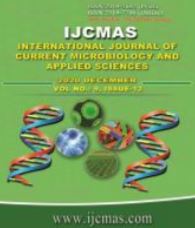


 National Academy of Agricultural Sciences (NAAS)
National Academy of Agricultural Sciences (NAAS)

|
PRINT ISSN : 2319-7692
Online ISSN : 2319-7706 Issues : 12 per year Publisher : Excellent Publishers Email : editorijcmas@gmail.com / submit@ijcmas.com Editor-in-chief: Dr.M.Prakash Index Copernicus ICV 2018: 95.39 NAAS RATING 2020: 5.38 |
The study was conducted to determine the maturity stage that produced the best nutritive profile of taro. Biochemical analyses of six varieties of taro (white achahou, violet achahou, dabehou, gagne pôtè, guèdèguè and zoukoudjèrè) cultivated locally were determined at 6, 8, 10 and 12 months of maturity. Except fat content which remained constant, fiber, carbohydrate, ash, reducing sugars and starch contents increased with the reduction of water content of fresh corms while protein, total sugar and energy value decreased during maturation. The highest carbohydrate (84.20 ± 0.07 g/100 g) and starch (40.93 ± 0.62 g/100 g) were reached at the 10th month in Dabehou and fiber in Gagne pôtè (4.55 ± 0.01 g/100 g. Except sodium which decreased, Minerals increased during maturation. The highest macro-elements (potassium) were showed in White achiahou (1751.46 ± 1.01 mg/100g) and Gagne pôtè (1751.01 ± 2,39 mg/100g) and microelements (iron) in Violet achiahou (39.58 ± 1.22 ppm) at the 10th month. The highest water absorption capacity (374.02 ± 9.25%) and water solubility index (28.25 ± 0.71%) were obtained at 10 months in Dabehou. According to these results, the taros should be harvested at the 10th month of maturity to produce the best nutritive profile.
 |
 |
 |
 |
 |